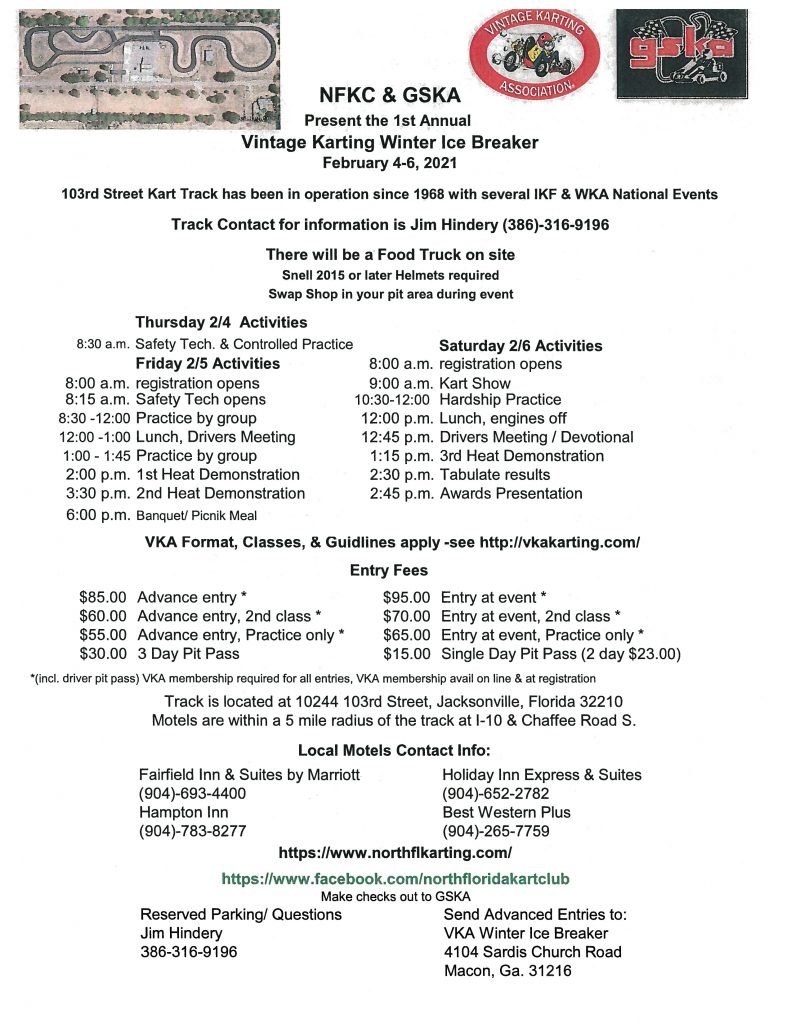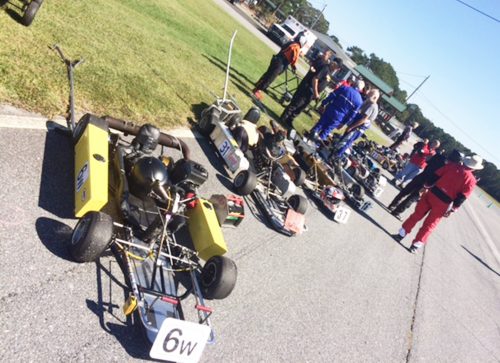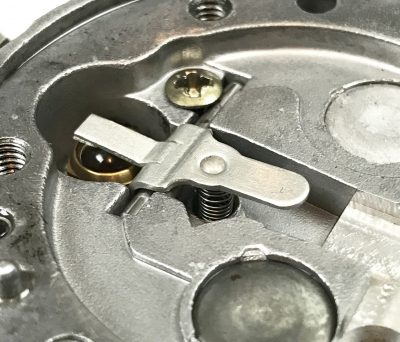Barnesville Driving Event Summary
By Bob Barthelemy
Photos by Brian Allardice
The Georgia weather was a little nippy Thursday morning with temperatures in the mid 40’s followed by temps over 70 by mid-day. Mother Nature was kind to us Thursday and Friday but on Saturday morning a heavy mist followed by a drizzle and later a downpour resulted in no on-track activity. Thank you to Mike Adkins, GSKA President, and the entire GSKA team for a well-run event! Thank you to all the Vintage Karters (44 entries) for participating at this event, and especially the large group from Saltillo, Mississippi.
After a round of safety tech inspections, the track was opened for practice at 9:15. We started with open practice for all single engine senior drivers with a max of 10 karts on the track at a time. The junior drivers were then allotted a practice session followed by the dual engine drivers taking their separate practice session. We repeated this order throughout the day and closed the track for practice at 5:00 pm. I believe everyone had plenty of practice time.


Friday morning temperatures were in the mid-50’s and rose to the mid-70’s and it was an absolutely gorgeous day. Practice began at 9:00 and went through noon. After the lunch break, we conducted our driver’s meeting including a brief devotional recognizing what God did to save Bill Jackson’s life and to pay respects to my friend, Ronnie Smith, who recently passed away (I conducted the eulogy at his funeral Saturday morning). After a few last-minute corrections to our running order to ensure participants were not driving in back-to-back classes, we were able to get the first Heats started by 1:45 pm. We had 13 classes represented, and by grouping some of the classes together, we were able to run 10 groups. We proceeded with our 1st and 2nd round of demonstration Heats. All Heats went smoothly with no substantial incidents on the track.

We all enjoyed a great evening buffet meal (chicken and rice, pork loin, and a wide range of vegetables and salad) prepared and served by Vicki & Glenn Forsyth in the concession/registration pavilion (outside to comply with COVID-19 protocol). “Legends of Karting” awards were presented in recognition to Dicky Wilson and Bill Berry by Bob Barthelemy. A Longest Distanced Traveled award was presented to Romero Llamas from Canton, Ohio. Romero was also presented the coveted traveling “Yankee Award”. He will be able to cherish it for only five months due to the 2021 Barnesville event scheduled for the March 25th-thru the 27th weekend, when it will be presented to another honored recipient.
Due to the continuing rain Saturday morning, the vintage karters in attendance voted to call the 3rd Heat. We then presented the awards for the demonstrations (based on finishing order of the 2nd Heat) and finished before 12:00 noon.












 I may have jumped the gun with my initial announcement last month of the International Kart Day, but in my defense, it was necessary. The part I didn’t explain in the December announcement was that the process started in 2019. There is a website that manages/publishes a calendar of “National Days.” They made it clear they get thousands of requests every year. (Keeping in mind we have national pizza day, national lemon meringue pie day, national hot dog day, and even national clean out your refrigerator day [right before Thanksgiving], it is no wonder they get thousands of requests.) They also made it clear they don’t notify applicants until it is approved…. and they didn’t. They also said they would not accept applications from “individuals.” I submitted the request as “Editor, VKA FirsTurn,” but I guess that didn’t carry any weight. Go figure. So, I asked Gary Wlodarsky, VKA President, if he would sign a “Declaration” that established the day. He was agreeable and the VKA Board approved. I re-applied in November.
I may have jumped the gun with my initial announcement last month of the International Kart Day, but in my defense, it was necessary. The part I didn’t explain in the December announcement was that the process started in 2019. There is a website that manages/publishes a calendar of “National Days.” They made it clear they get thousands of requests every year. (Keeping in mind we have national pizza day, national lemon meringue pie day, national hot dog day, and even national clean out your refrigerator day [right before Thanksgiving], it is no wonder they get thousands of requests.) They also made it clear they don’t notify applicants until it is approved…. and they didn’t. They also said they would not accept applications from “individuals.” I submitted the request as “Editor, VKA FirsTurn,” but I guess that didn’t carry any weight. Go figure. So, I asked Gary Wlodarsky, VKA President, if he would sign a “Declaration” that established the day. He was agreeable and the VKA Board approved. I re-applied in November.
 As you can see The VKA Board is upgrading its operations for 2021 with a new website and a digital version of FirsTurn. The primary goal is for you, the VKA member to have a better experience as a participant at VKA events, and as a vintage karting enthusiast in general. To make this happen, we need your help. Simply put, without information on you and your karts, we cannot do any meaningful event coverage. We need to be able to identify your kart by either a number panel when on the track or a show entry card with a visible number on it. Then we need a corresponding race or show entry form with as much info as possible about the kart and yourself, like where you live. Without this we can only run random photos with no captions that have no relevance.
As you can see The VKA Board is upgrading its operations for 2021 with a new website and a digital version of FirsTurn. The primary goal is for you, the VKA member to have a better experience as a participant at VKA events, and as a vintage karting enthusiast in general. To make this happen, we need your help. Simply put, without information on you and your karts, we cannot do any meaningful event coverage. We need to be able to identify your kart by either a number panel when on the track or a show entry card with a visible number on it. Then we need a corresponding race or show entry form with as much info as possible about the kart and yourself, like where you live. Without this we can only run random photos with no captions that have no relevance.





















